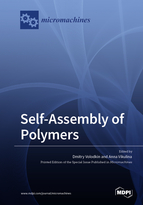Self-Assembly of Polymers
A special issue of Micromachines (ISSN 2072-666X). This special issue belongs to the section "D:Materials and Processing".
Deadline for manuscript submissions: closed (31 August 2018) | Viewed by 57354
Special Issue Editors
Interests: polymer self-assembly; encapsulation and release of bioactive molecules; microfluidics; raman microscopy; hard and soft templating; polymer scaffolds; cell-surface engineering; 2D and 3D cell culture
Special Issues, Collections and Topics in MDPI journals
Interests: lipid assembly; lipid chemistry and analysis; liposomes; molecular transport; diffusion phenomenon; controlled release; drug delivery; biomedical applications
Special Issue Information
Dear Colleagues,
Nowadays, polymer self-assembly has become extremely attractive for both biological (drug delivery, tissue engineering, scaffolds) and non-biological (packaging, semiconductors) applications. In nature, a number of key biological processes are driven by polymer self-assembly, for instance protein folding. Impressive morphologies can be assembled from polymers thanks to a diverse range of interactions involved, e.g., electrostatics, hydrophobic, hots-guest interactions, etc. Both 2D and 3D tailor-made assemblies can be designed through modern powerful techniques and approaches such as the layer-by-layer and the Langmuir-Blodgett deposition, hard and soft templating.
This Special Issue highlights contributions (research papers, short communications, review articles) that focus on recent developments in polymer self-assembly for both fundamental understanding the assembly phenomenon and real applications. Particular attention is paid to:
- microfluidic-assisted self-assembly
- design of (bio)polymer based devices and films
- colloidal particles and multilayers
- core-shell structures
- bio-functional self-assembled structures
- hybrid polymer assemblies with lipids and nanoparticles
- polymer mobility and structure of self-assemblies
- mechanism of polymer self-assembly
Contributions related to new technologies and material aspects of polymer assemblies are very welcome.
Prof. Dr. Dmitry Volodkin
Dr. Anna Vikulina
Guest Editors
Manuscript Submission Information
Manuscripts should be submitted online at www.mdpi.com by registering and logging in to this website. Once you are registered, click here to go to the submission form. Manuscripts can be submitted until the deadline. All submissions that pass pre-check are peer-reviewed. Accepted papers will be published continuously in the journal (as soon as accepted) and will be listed together on the special issue website. Research articles, review articles as well as short communications are invited. For planned papers, a title and short abstract (about 100 words) can be sent to the Editorial Office for announcement on this website.
Submitted manuscripts should not have been published previously, nor be under consideration for publication elsewhere (except conference proceedings papers). All manuscripts are thoroughly refereed through a single-blind peer-review process. A guide for authors and other relevant information for submission of manuscripts is available on the Instructions for Authors page. Micromachines is an international peer-reviewed open access monthly journal published by MDPI.
Please visit the Instructions for Authors page before submitting a manuscript. The Article Processing Charge (APC) for publication in this open access journal is 2600 CHF (Swiss Francs). Submitted papers should be well formatted and use good English. Authors may use MDPI's English editing service prior to publication or during author revisions.
Keywords
- Self-assembly
- Polymer
- Multilayers
- Core-shell
- Hybrid Materials
- Lipids
- Nanoparticles
- Biopolymers
Related Special Issue
- Hybrid and Polymer Assemblies in Micromachines (6 articles)








